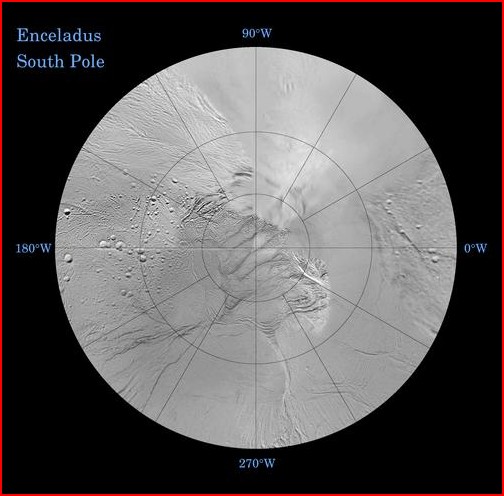
home •
about •
essential guide •
picture of the day •
thunderblogs •
news •
multimedia •
predictions •
products •
get involved •
contact

Credit: NASA/JPL/Space Science Institute
pic of the day
archive
subject index
abstract
archive
Links:
Society for
Interdisciplinary
Studies
Sep 08, 2005
EDM on Enceladus
Further data from Cassini’s close flyby of Saturn’s moon, Enceladus, confirms ongoing electrical activity.
In our Picture of the Day for August 9, 2005, The Hot Poles of Enceladus, we noted:
“In the electric view, the warm rilles and hot pole are electrically heated. The water vapor from the rilles is being electrically “machined” from them.”
The release of further data from the Cassini probe confirms the present activity of an electrical discharge machining (EDM) process. As Cassini passed close by Enceladus’ south pole on July 14, 2005, it detected a large increase in water vapor and ice particles. Scientists compared the detections to similar ones in flybys of comets, but they hastened to add that these were caused by internal heat, not heating by the sun as they believe to be the case with comets. Enceladus is a Saturnian variant of Jupiter’s moon, Io, with electrical activity in an “auroral zone” around Enceladus’ pole.
The Electric Universe emphasizes the similarity. In the electric view, the emission of gases and particles from comets is not due to solar heating but to EDM from the potential difference between the comet nucleus and the surrounding solar electric field. Because Enceladus orbits within Saturn’s plasmasphere, it’s emission of gases and particles is due to EDM from the potential difference between it and the surrounding Saturnian electric field.
Cassini has already mapped the “bending” of Saturn’s magnetic field around Enceladus “due to electric currents generated by the interaction of atmospheric particles and the magnetosphere of Saturn”. The Electric Universe would reverse this cause and effect, attributing the interaction (and presence) of particles to the electric currents.
The pinch effect will squeeze the current channels down to small diameters, producing many filaments that carry the total current. Where the filaments impinge on the surface, they will create “hot spots” as they electrically “machine” away material and pull much of it into space. Detailed measurements during close flybys should detect these filaments as “jets” of vapor, ice and dust. Water vapor that escapes the filaments will crystallize on the surface nearby, becoming the ice that is “very young ... between 10 and 1,000 years old” observed by Cassini.
Because the voltage at Enceladus is much less than that at comets, the current is in the “dark discharge” mode rather than in the “glow” mode. The jets and sheaths (comas) of comets shine in visible light because the current density is sufficient to excite atoms and ions to emit light. Lower current densities result in excitation in radio wavelengths; although invisible to the human eye, the jets perform the same work of etching the surface. As they move along the surface, they leave evidence of their activities in the shape of the trenches.
EXECUTIVE EDITORS:
David Talbott, Wallace Thornhill
MANAGING EDITOR:
Mel Acheson
CONTRIBUTING EDITORS: Michael Armstrong, Dwardu Cardona, Ev Cochrane,
C.J. Ransom, Don Scott, Rens van der Sluijs, Ian Tresman
WEBMASTER: Michael Armstrong
Copyright 2005: thunderbolts.info